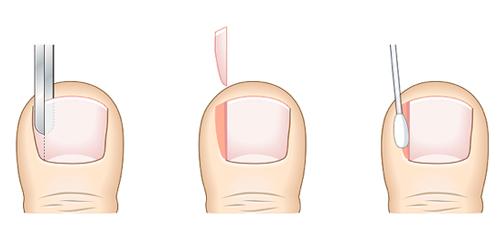Permanent Toenail Removal
There are two types of procedures to remove a toenail:
Matrixectomy – introducing a chemical substance to the nail matrix to prevent that section of the toenail from growing back permanently.
Interesting Fact: With proper techniques and procedures for a permanent ingrown toenail removal, there is a 97.9% success rate with no reoccurrence (Tatlican et al., 2009).
Partial Nail Avulsion (PNA)
The most common procedure is a PNA with matrixectomy. This is a minimally invasive permanent solution to remove the small edge of the toenail that is growing downwards/inwards, piercing the skin and causing your painful symptoms. It is a safe and effective solution to remove the frustrating and painful ingrown toenails.
The affected toe is “frozen” with a local anesthetic, a sliver of the infected or ingrown toenail is removed, and a chemical substance is introduced to the nail matrix to prevent that section of the nail from growing back permanently.
We will dress your toe and provide you with an aftercare instruction handout as well as antibiotic cream and bandages.

Benefits of a PNA procedure include:
- The procedure is done in the clinic
- Performed under local anesthetic so it is pain-free
- Total appointment time typically does not exceed 45 minutes, with the procedure itself usually taking less than 20 minutes
- The procedure causes very little post-operative discomfort, but painkillers can be taken should discomfort arise
- You do not need to take additional time off work/school following the procedure
- You do not need any special boot or brace while the toe is healing
A nail avulsion without matrixectomy is another procedural technique we perform to allow the toenail to regrow after removing the problematic toenail.
A Total Nail Avulsion is another non-invasive procedure the chiropodist performs when a partial nail avulsion may not be recommended.
Ready for your first visit?
Book an appointment today or call us at (416) 444-3668 to learn more about our foot care services.
DeLauro, N. M., & DeLauro, T. M. (2004). Onychocryptosis. Clinics in Podiatric Medicine and Surgery, 21(4), 617–630.
Tatlican, S., Yamangöktürk, B., Eren, C., Eskioğlu, F., & Adiyaman, S. (2009). Comparison of phenol applications of different durations for the cauterization of the germinal matrix: an efficacy and safety study. Turkish Association of Orthopaedics and Traumatology, 43(4), 298–302.
Haneke E. (2012). Controversies in the treatment of ingrown nails. Dermatology Research and Practice, 2012, 783924.
